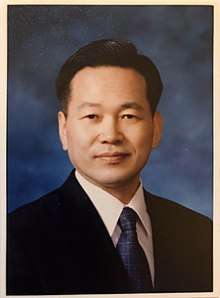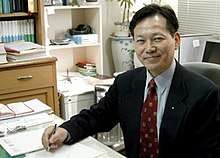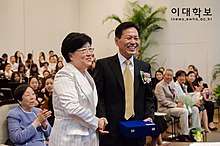Yong Seung Cho
Yong Seung Cho (Sep. 18, 1949) Hangul: 조용승 is an educator and mathematician from the Republic of Korea. He completed a Ph.D. in mathematics in 1987 at the University of Chicago. His research interests include geometric topology, Yang-Mills Theory, Seiberg-Witten Theory, Gromov-Witten Theory, and Quantum cohomology of symplectic manifolds. His teaching career includes Chungbuk National University, Kyungpook National University, Brandeis University, and Ewha Womans University. Currently he teaches at Sungkyunkwan University as Invited Professor. In 2003, he was elected as President of the Korean Mathematical Society (KMS)],[1] and at the position, he played a pivotal role in establishing the National Institute for Mathematical Sciences (NIMS) in Korea, the first national mathematical research center directly funded by Korean government. In 2005, he was selected as the first President of NIMS, and immediately began to set-up fundamental foundation of the NIMS to be innovative hub of the mathematical researches contributing to the Korea's overall scientific and industrial competitiveness.[2][3]
Yong Seung Cho | |
|---|---|
 | |
| Born | September 18, 1949 (age 70) Suncheon, South Korea |
| Spouse(s) | Su-Nam K. Cho |
| Children | 2 |
Education and Career
Professor Cho attended Kyungpook National University for bachelor and master programs in mathematics, and earned a doctorate in 1987 from The University of Chicago under the academic direction of Melvin Rothenburg, Karen Uhlenbeck, and Shmuel Weinberger. He became an assistant professor at Brandeis University in 1987, and moved to Ewha Womans University in Seoul as a full professor in 1989. He taught and researched at Ewha Womans University until retirement in 2015.
Image:

Mathematical work
Professor Cho has been a pure scientist for his entire life. He has researched on Yang-Mills Theory, Seiberg-Witten Theory, Gromov-Witten Theory, and Quantum cohomology of symplectic manifolds. Besides, he achieved a remarkable result on Big-Bang String Theory, [4][5][7] that is, as the early universe he used the string theory with Einstein's general relativity and Morse Theory to verify the expansion, shear, and rotation of the universe. Professor Cho's result was co-worked with physicist Professor ST Hong, so it is named “Cho-Hong String Theory.”[4][5][6] Also Professor Cho initiated the Gromov-Witten type invariant, quantum type cohomology, and Floer type cohomology on cosymplectic manifolds, and induced an Arnold type theorem on odd dimensional manifolds. Professor Cho has published more than 130 academic research papers, and more than 15 text books on Topology, and has delivered more than 230 special lectures at various international conferences and scholarly events, including American Mathematical Society's Annual Conference and Harvard Math Colloquium Lecture Series.
Service
Professor Cho has been active in advancing Korean mathematical research capabilities and national science development by holding several positions. Professor Cho held President position of the Korean Mathematical Society (KMS, 2003.1-2004.12), and during this position, Professor Cho played a critical role in establishing the National Institute for Mathematical Sciences (NIMS) in Korea, the first national mathematical research center directly funded by Korean government. Professor Cho became the first President of NIMS (2005-2008) and set-up foundation of the NIMS to be innovative hub of the mathematical researches contributing to the Korea's overall mathematical researches and scientific competitiveness. Professor Cho also held Council member position of Presidential Council on National Science and Technology; led a math mentorship for ROK Science Gifted Student Academy; and wrote science columns as Editorial Writer for Kookmin Ilbo, and other national newspapers. Professor Cho's four books are awarded as the Best Books of the Year by the National Academy of Sciences, Republic of Korea, in recognition of creative works that help the public understanding in sciences (2019 Topology, 2019 Differentiable Manifolds, 2011 Algebraic Topology, and 2002 Topology on Differentiable Manifolds).[7][8][9]
Professor Cho has been one of executive editors of Journal of Korean Mathematical Society (KMS) and Bulletin of KMS. Professor Cho has been journal reviewers of American Mathematical Society (AMS) and European Mathematical Society (EMS).
Awards and honors
Professor Cho has received several honors and awards, including -"The Presidential Honors, President of the Republic of Korea Park Geun Hye (대한민국 대통령 옥조근정훈장, 2015),”
-“The 10th Ewha Academic Award (이화학술상, 2014)”,
-“Mathematics Award, Microsoft Korea Inc. (마이크로소프트 수학상, 2003),”
-"Ewha Womans University “Award for Outstanding Science and Technology Papers,(이화여대 최고우수논문상 수상, 2001)”,[10]
-"Korean Federation of Science and Technology Societies (한국과학기술총연합회 우수논문상, 1992)”
-Professor Cho had been university fellow at the University of Chicago during his entire graduate studies in 1984–1987.
Image:

Personal life
Professor Cho married his wife, Su Nam (Kim) Cho, in January 1980. They had two sons together: Hyunbae Cho and Ihnbae Cho. Wife Su-Nam Kim Cho was adjunct professor at Sookmyung Women's University's Graduate School of International Service (GSIS) and worked at the U.S. Embassy in Seoul; both sons are Doctors of Dental Surgery(DDS) in the United States - Hyunbae is from New York University DDS, and Ihnbae is from the University of Southern California DDS. First son Hyunbae married Eunmee (Lee) Cho (USC DDS) and have two children Gia and Sua.
Notes and references
- 창간축사-“수학대중화의 우군 돼달라” 조용승 대한수학회장, 교수신문 2004.04.12
- 국가수리과학연구소 대덕 '입성'-2003년부터 3년간 설립 추진...조용승 이대 교수, 초대 소장 '취임', 헬로대덕신문, 2005년11월1일
- 수학계 오랜 숙원 푼 '수리과학硏' 개소, 10일 기초硏 강당서 개소식 개최...100여명 참석 '성공 기원', 헬로대덕신문, 2006/06/10
- 끈이론으로 우주생성 규명, 이화여대 조용승 홍순태 교수, EBS news, 2011.6.11
- 끈 이론으로 우주 생성을 새롭게 규명 - 올해의 10대 과학기술뉴스, 한국과학기술단체총연합회
- 우주 생성 “끈이론” 조용승 교수 정년퇴임, 경향신문 2015년 2월2일
- 한국의인물-수학자부문: 이화여자대학교 수학과 조용승 교수, 이슈메이커, 2014년9월4일
- 수학과 이론물리학의 상관성, 대한수학회 뉴스레터 제 64 호 1999년 3월 2-9쪽
- 본교 교수 저서 8종, 2019년 대한민국학술원 우수학술도서 선정, 이화여대 홈페이지, 2019년 7월12일
- 이화학술상 수상자, 조용승 교수 선정 - 30일 이화여대 창립 128주년 기념식서 시상, 2014년 5월18일
External links
- Yong Seung Cho’s homepage - His homepage contains CV, list of published journals, books, articles, presentations, and advisees.